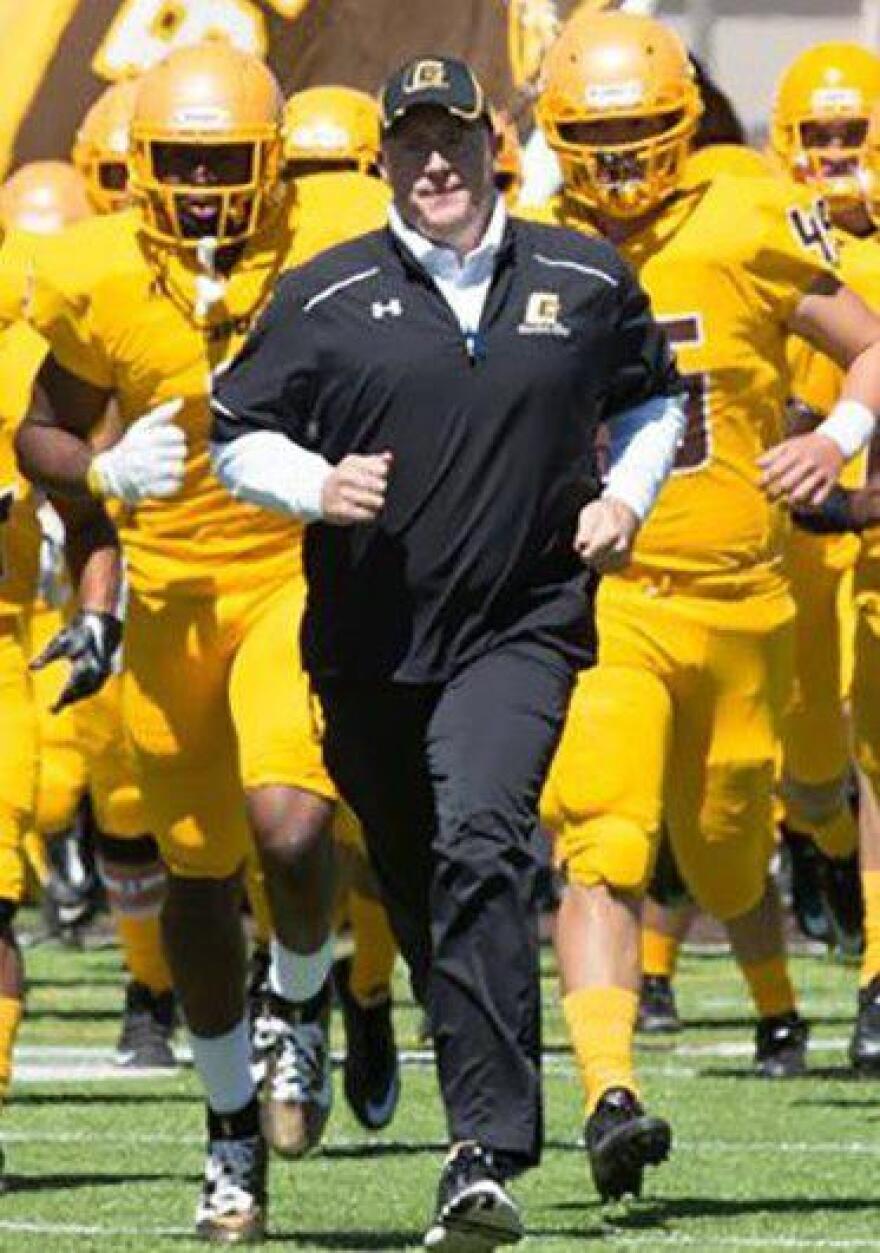Last August, a mother put her youngest son on a plane in New Jersey bound for Garden City Community College to play football in southwestern Kansas.
Just 48 hours later, the 19-year-old was dead.
The family knows how and when Braeden Bradforth died.
But in the six months since he collapsed in a narrow alley after a grueling conditioning practice in Broncbuster Stadium, questions remain about whether the death was preventable.
Here is what we know for sure: Bradforth died from “exertional heat stroke” at 11:06 p.m. Aug. 1, according to an autopsy. He died two hours after his second practice following his arrival in Garden City.
Unlike other players, he did not participate in conditioning earlier in the summer because his scholarship offer came just one week before he was to report.
It was 84 degrees at that practice, generally hotter than the Jersey Shore at night. And he was, for the first time in his life, 2,800 feet above sea level. The heat and elevation, one expert says, most likely contributed to his death. A lack of water at practice might have also played a role.
Prevailing medical literature suggests those factors put the powerful lineman through too much too quickly during the very warm evening workout without the safeguards in place to save him when his massive frame ultimately overheated.

“I spoke to him at 6:45 (p.m.) and he was fine and the next phone call I got he was deceased and I need to know what happened in between that time,” said Bradforth’s mother, Joanne Atkins-Ingram.
“I was sending him out his first college boxes,” she told KCUR on her visit to Garden City. “One box was full of the typical college stuff, Oodles of Noodles, gummy bears, things of that sort, enough for him and his roommate. And then the other box was the essentials, underwear, socks, sneakers.”
Jeff Sims, the very successful junior college team’s coach at the time, did not respond to an email seeking comment for this story. Efforts to reach him through his new employer, Missouri Southern State University, were unsuccessful.
GCCC officials declined an interview to talk about the autopsy or anything else surrounding the young man’s death.
Missouri Southern officials said they knew of Bradforth’s death when they interviewed Sims for his new job, but wouldn’t comment on the circumstances.
Initially, the Garden City coach told reporters that Bradforth died from a blood clot.
Junior college route
Bradforth grew up in Neptune, New Jersey, a shore town near Asbury Park. He had never been to Kansas and when he left for Garden City it was only his second time on a plane.
He struggled as a student, but he excelled at football.
“We all knew Breaden was an outstanding athlete especially for his size,” Jill Greene, the family’s New Jersey lawyer said.
Greene has been a family friend for 20 years. She knew Bradforth almost his whole life.
Greene described the teen, 6 feet 3 inches tall and 300 pounds, as “a gentle giant with a beautiful smile.”
Video on his hudl.com page shows a lineman quicker and more agile than most players his size.

“He was just very, very athletic and a great football player,” Greene said.
Ingram was worried about her youngest son going to college so far from home. She talked about it on a Facebook page that friends of the family followed.
“I remember posting a comment saying, ‘Don’t worry, Joanne, he’s in good hands,’” Greene remembers. “And that haunts me because boy, I couldn’t have been more wrong.”
So, in late January, Bradforth’s mom and lawyer left the Jersey Shore for western Kansas.
They were on the GCCC campus trying to find the exact spot Bradforth collapsed after practice.
“I just don’t know what I feel right now. I feel hurt,” Ingram said. “I feel these are adults who are responsible for my child.”
The adult Ingram blames is Sims.
He was a superstar among the junior college football ranks.
His team won a national championship at GCCC in 2016. Last year, his team played for the national championship. Earlier he had coached Fort Scott Community College to the national championship game in 2006.
That success led him out of the junior college ranks and to Missouri Southern in Joplin.

In a YouTube video from Husker Online, a video service connected to the University of Nebraska, Sims was very clear about how hard he works his players.
“Sometimes sugar don’t work, so you have to get on ’em and get them to understand,” he said in the October 2018 interview. “They’ll say to you, ‘I’m working hard.’ No, you’re working as hard as you’ve ever worked but you’re not working as hard as it takes.”
Sims also says in that same video that, “You get into coaching because you care about people and you want to help people get somewhere.” A former player described Sims as caring one-on-one, but harsh on the field.
A workout, and a collapse
Practice ended at around 9 p.m. While the rest of the team headed to a meeting, Bradforth headed in the opposite direction, toward the dorm. No one checked on him.
He was “down around 20-30 minutes” when a teammate found him, according to an emergency medical services report. Various media have reported that a teammate called a coach, who called Sims, who then called the team’s trainer. An ambulance arrived at 10:10 p.m., more than an hour after practice and at least 30 minutes after Bradforth was discovered.
“Patient was unresponsive but breathing,” the report said. “Patient was moaning and was wet.”
It turns out GCCC staff tried to cool Bradforth down with a hose, according to the EMS report. Athletic training standards suggest, however, that cold water from a hose wouldn’t be enough to lower his core temperature significantly.
Paramedics also wrote that “coaches made all players go back to rooms so any witness(es), if any, were not present at this time.”

The ambulance crew worked on the young man for a few minutes. As Bradforth was loaded onto a stretcher, he began to vomit. He arrived at St. Catherine Hospital’s emergency department at 10:33 p.m. His heart soon stopped and he was declared dead at 11:06 p.m. Two hours after practice. Two days after arriving in Garden City. Some 1,500 miles from home.
Sims told reporters from Garden City to New York that Bradforth died from a blood clot. But the autopsy that was released later, in December, was clear. The teen died of exertional heat stroke.
Since Bradforth’s death, KCUR has learned a few things about the workout that led to the teen’s death.
First, the practice consisted of 36, 50-yard sprints. That is about a mile. Bradforth had to run each sprint in under eight seconds.
“That’s a do-or-die drill,” Randy Eichner told KCUR. “That is reckless endangerment.”
Eichner is a physician and leading expert in preventing heat stroke in athletes. He co-authored a consensus statement on heat stroke published in the Journal of Athletic Training and he was the team doctor for the University of Oklahoma football team for 15 years. He is now consulting Bradforth’s family.
“Individuals should be acclimatized to the heat gradually over 7 to 14 days,” according to a consensus statement in the Journal of Athletic Training.
Bradforth participated in an intense workout in only his second practice.
A fellow player said he was exhibiting signs consistent with exertional heat stroke, or EHS, during the workout and later when he wandered off toward his dorm. That player said Bradforth fell to his knees during the sprints and appeared disoriented.
The ?rst sign of EHS is often an athlete collapsing, aggressiveness or confusion, the National Athletic Trainers’ Association paper said.
Bradforth was also exercising at an altitude he had never experienced.

“I think you have a hot day, high temperatures. I think you have a coach who doesn't know his player,” said Green, the family lawyer.
People there that day also told KCUR that Sims withheld water during that August conditioning practice.
Johnny Jean, a safety from Florida and the player who recalls Bradforth disoriented during the workout, was among them.
“When we first started, I thought they were crazy. I ain’t never been at practice when they said we couldn’t get water,” Jean said. “During the whole summer, we weren’t allowed to get water during practice then we started drinking water during fall camp when you start playing games.”

A former GCCC player and the parent of another former player also said water was denied during conditioning drills.
Best practices
Eichner calls practices like that part of a warrior culture. “They still use primitive ways of coaching that can trigger heat stroke.”
Denying water also flies in the face of best practices.
“Players should have free access to readily available ?uids at all times, not just during designated breaks,” according to the position statement from the National Athletic Trainers’Association.
Neither GCCC nor Missouri Southern would comment. GCCC would not say if the coach who replaced Sims allows players to drink during conditioning drills. Missouri Southern would not say if Sims allows players to drink water during conditioning there.
GCCC has said little about Bradforth’s death. It conducted an internal review that was completed Feb. 1, according to college spokesperson Ashley Salazar.
KCUR asked for the report under the Kansas Open Records Act but was denied because, the college said, it is covered by attorney-client privilege.
GCCC issued a statement after the autopsy was released in December touting its internal review.
“The ongoing review is intended to ensure that the college can transparently inform the community, the media, and — most importantly — Braeden’s family of the accurate facts and circumstances surrounding Braeden’s death,” the statement said.
KCUR also asked for the letter or email from GCCC’s lawyer requesting the internal review. The college said such communication did not exist.
The internal review was done by the college’s interim athletic director with assistance from the chief of the campus police department, according to Salazar.
The family’s lawyer said she has gotten no information from the college.
“What have you got to hide? If nobody did anything wrong just be forthcoming,” Greene said.
New Jersey state Sen. Vic Gopal, who represents Neptune, has written Kansas Attorney General Derek Schmidt calling for an investigation by the state into Bradforth’s death.
“His death created a shock through the community I both govern and love,” Gopal wrote. “This matter needs the force, authority, and expertise that only the Kansas Attorney General’s Office can provide.”
That News Jersey lawmaker noted that neither the Garden City police nor the GCCC police investigated Bradforth’s death.
A spokesman for Schmidt said in an email that, “We have received the letter and it is under internal review.”
Players dying as a result of workouts is not unusual in college football. Last September, HBO’s Real Sports reported that 30 college football players have died from workouts since 2000, almost two a year. That total does not include Bradforth's death.
Heat stroke death is also a problem at the high school level. Between 1995 and 2017, 47 high school players died of heat stroke, according to the National Center for Catastrophic Sports Injury Research at the University of North Carolina.
That report also stressed that heat stroke is usually preventable.
“Prevention messages must go beyond hydrating but emphasize how to properly hydrate, how to acclimate to the environment, how to acclimate to the addition of equipment, and achieve the appropriate fitness baseline for the intended rigors of practice,” the 2017 report said.
Eichner, the physician working with the family, said it doesn’t matter whether someone is coaching in a big-time college program, junior college or high school.
“These coaches need to do it right or they shouldn’t be given the responsibility of training someone else’s son,” he said. “They’re killing our kids.”
While no lawsuit has been filed, the family did put GCCC on notice that it may sue.
For now, Bradforth’s mother struggles every day with her son’s death.
“It’s so hard because every day I still feel like at some point he’s going to call me and say, ‘Mom, you gotta send me some money’ or, ‘Did you get my ticket to come home for the holidays?’”
Sam Zeff is KCUR's metro reporter. You can follow Sam on Twitter @samzeff.
This story incorrectly reported that 30 college football players died from heat stroke. That number is all deaths attributed to football workouts since 2000.








